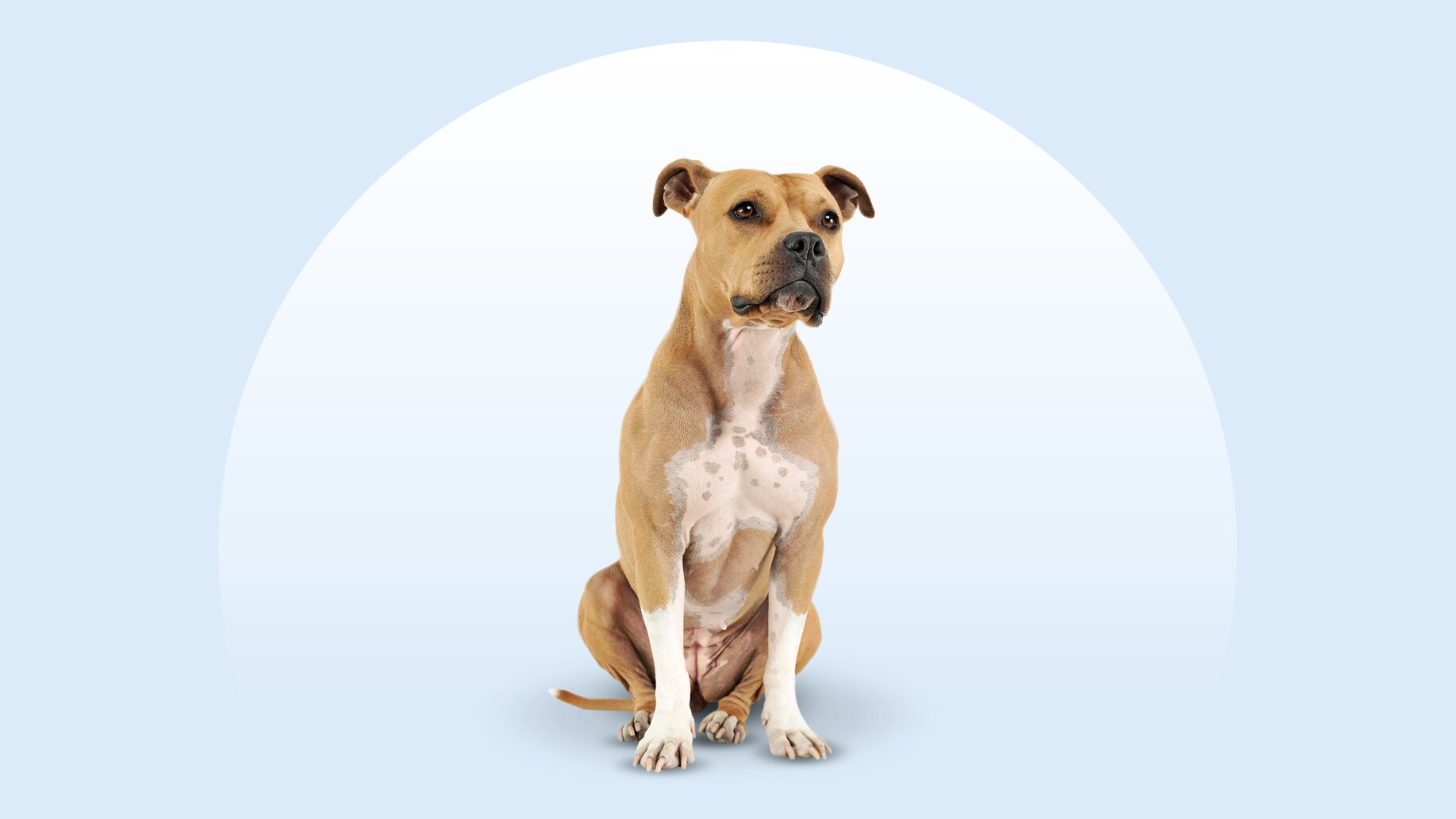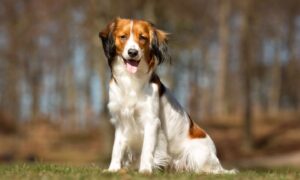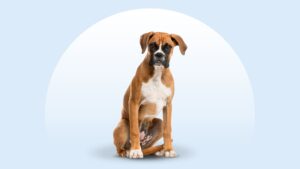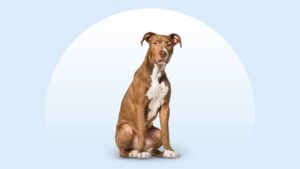American Staffordshire Terrier
Updated December 15, 2025
American Staffordshire Terrier
Updated December 15, 2025
American Staffordshire Terriers are friendly, energetic pups who live for playtime—and all the goofy antics that come with it. They thrive in family environments and, if you’re longing for games of fetch or tug-of-war with a friend who makes you laugh, an AmStaff might be your soul pup.
Devoted, Funny, Playful
40–70 pounds
17–19 inches
12–16 years
Black, White, Brown, Blue, Fawn Sable, Blue Fawn, Red Brindle, Blue Fawn Brindle, Liver, Black Brindle, Fawn Brindle, Blue Brindle, Liver Brindle, Fawn, Red, Seal Brown, Red Sable, Brown Brindle
Rambunctious and funny, the American Staffordshire Terrier is not a serious dog. They love their toys, they love being around people, and they always have a big smile on their face.
AmStaffs, as they’re commonly called, are affectionate dogs and need you to return the love. They may be muscular, but inside they are just big softies who’ll probably want to carry their favorite plush toy around wherever they go.
American Staffordshire Terrier Characteristics
American Staffordshire Terrier Appearance
American Staffordshire Terriers are medium-sized, stocky dogs who come in a variety of colors and patterns.
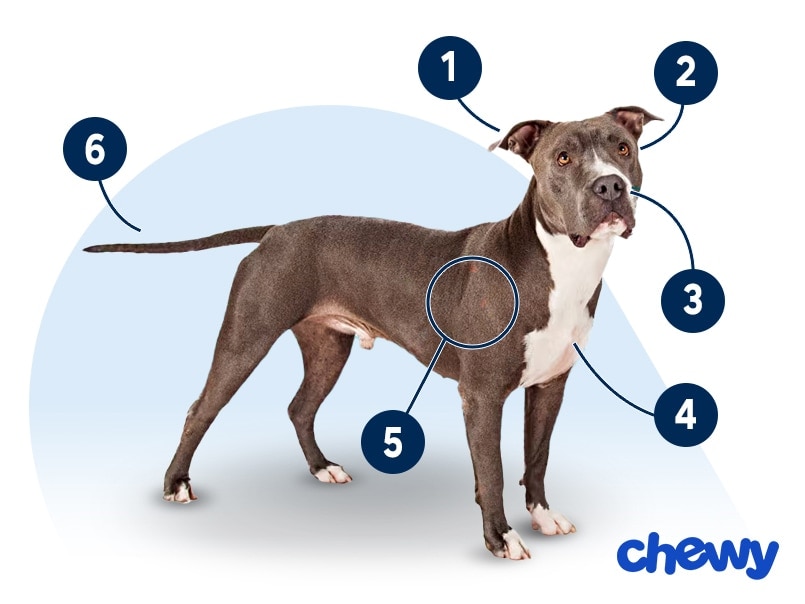
- Ears
While it was once common to crop ears, nowadays many AmStaff dogs’ ears are left floppy. Many groups, including the American Veterinary Medical Association, oppose ear cropping, and many countries as well as U.S. states have banned the practice.
- Eyes
Their eyes are round and dark.
- Nose
An AmStaff’s nose is black.
- Coat Length
The American Staffordshire Terrier coat is short and glossy.
- Coat Color
AmStaff colors run the gamut—there are up to 18, including shades of black, blue, bronze, fawn, liver (chocolate), red, brown, and white. Their coat can also have a range of markings.
- Tail
Their tapered tail is set low.
American Staffordshire Terrier Temperament
American Staffordshire Terriers are extremely bright and always ready for playtime (although they’ll definitely enjoy their couch time, too). They want to be part of an active family whose schedules are packed with hikes, walks, fun games, scent work, or dog sports like agility trials.
These pups love people, so they’re often delighted to be introduced to someone new (as long as they’ve been properly socialized to be comfortable around strangers, that is). When it comes to other pets, they might want to be your only fur baby. But each dog’s an individual, and some AmStaffs might enjoy canine siblings.
AmStaffs are sensitive souls who need to know you love them as much as they adore you. Show them with dog treats, lots of petting, consistent playtime and exercise, and round-the-clock snuggles. In return, they’ll let their goofy side show, and you’ll never be without a laugh.
The American Staffordshire Terrier’s temperament means they’re usually good with older children who know how to appropriately interact with dogs, and they often don’t mind the hustle and bustle of a busy household. They love the opportunity to be active, after all, and more people just means more opportunities to play fetch.
How to Care for a American Staffordshire Terrier
The American Staffordshire Terrier dog breed doesn’t require a lot of grooming time. But these smart dogs will enjoy putting their cleverness toward obedience training and need a dedicated exercise routine.
Grooming
Training
Diet
Exercise
Environment
American Staffordshire Terrier Health
The typical American Staffordshire Terrier lifespan is 12–16 years. Here are some health issues to be aware of.
- Allergies: AmStaff dogs can be prone to allergies from their food or environment. Watch out for itchiness, licking, or scratching, and talk to your vet if you notice any of these symptoms.
- Bloat and gastric dilatation-volvulus: Bloat is a condition where the stomach distends with food and/or gas. Sometimes, the stomach can twist, leading to gastric dilatation-volvulus. Symptoms include pacing, restlessness, excessive panting and drooling, retching without vomiting, and a distended abdomen. Go to the vet ASAP if you suspect bloat in your dog, as this is a life-threatening emergency.
- Cerebellar ataxia: Signs of ataxia in dogs include stiffness, loss of balance, head tremors, and rapid eye movements. There’s no cure, but see your vet immediately if you notice these signs.
- Elbow and hip dysplasia: Elbow and hip dysplasia are genetic conditions that develop during puppyhood when the joints don’t align well and become looser than normal. Signs include limping, and treatment might involve weight loss, joint supplements, physical therapy, or even surgery.
- Heart issues: These pups can be prone to heart murmurs and mitral valve disease, where the heart doesn’t pump blood efficiently. A heart murmur can be the earliest sign of mitral valve disease, but other symptoms include exercise intolerance, a cough, heavy breathing, an inability to rest, and decreased appetite. Treatment includes oral medications and rest; prognosis depends on how severe the disease is when diagnosed.
- Hypothyroidism: Hypothyroidism includes symptoms like lethargy, hair loss, skin and ear infections, and weight gain. A blood test can diagnosis it, and treatment is a daily oral medication.
- Progressive retinal atrophy (PRA): PRA leads to blindness in dogs, and while there is no cure, pups who lose their eyesight tend to adapt well and can still live full, happy lives.
American Staffordshire Terrier History
The American Staffordshire Terrier has an admittedly sad origin story. They were first bred in England to be used in dog sports. People would bet on these events, and dogs were used for things like fighting and bull baiting, which was outlawed in 1835.
It’s thought that these pups are descended from English Bulldogs, as well as possibly terriers that have since gone extinct.
To be clear: These dogs were often used in fighting not because they possessed any natural meanness. On the contrary, their loyalty and desire to please their human made them malleable.
However, AmStaff dogs and related breeds were unfoundedly maligned by the media, which caused a drop in their popularity. While public sentiment surrounding these breeds has since changed, there is still prejudice out there, including breed-specific legislation, in which certain cities ban American Staffordshire Terriers or even just dogs who look like they might be one.
Despite being recognized as a breed by the American Kennel Club in 1972, the American Staffordshire Terrier, along with other Pit-Bull type of dogs, are regularly overlooked in shelters.
That’s why you should always consider American Staffordshire Terrier adoption, as there are so many of these misunderstood dogs patiently waiting for their forever homes. Look into a local rescue like New York American Staffordshire Terrier Rescue, make a visit to your local animal shelter to meet a pittie, or search Chewy’s database of adoptable dogs in your area.
